click on photos to enlarge
Three excellent Victorian teapots
It is common opinion that the 19th century and the Victorian Era were
a period of decline of the figurative arts and, particularly, of
silversmithing. However, among 'silver collectibles' (more than in the
field of 'great art') some exceptions may be found.
As an example of excellent quality silverware of the Victorian period we
present three teapots, manufactured between 1848 and 1869 by well known
English makers.
TEAPOT WITH ENGRAVED DECORATION - LONDON 1847
|
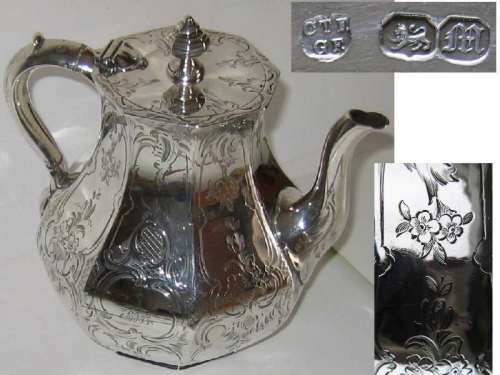
|
|
Height 7 1/2 in. (19 cm), width 7 1/2 in. (19 cm), weight 21
1/2 oz. (611 g)
|
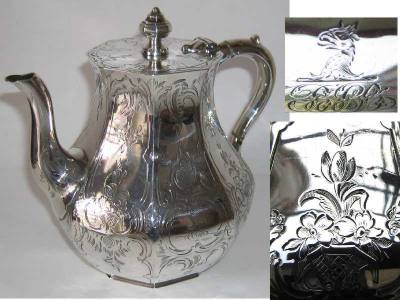 This teapot was manufactured in London by
Charles Thomas Fox and George Fox, belonging to an important
silversmith family.
This teapot was manufactured in London by
Charles Thomas Fox and George Fox, belonging to an important
silversmith family.
Five hallmarks are impressed underneath the base: CTF over GF (maker
mark); lion passant (sterling standard for silver, 925 ppt); leopard
head (Assay Office mark for London); an old English capital letter M
(date letter for 1847/1748); Queen Victoria head (duty mark).
|
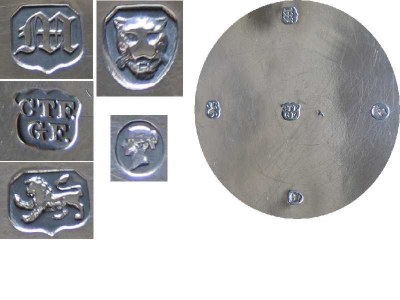 The lion passant, date letter and maker marks
are also struck on the handle, the lid and the finial.
The lion passant, date letter and maker marks
are also struck on the handle, the lid and the finial.
The teapot has octagonal shape and the handle is insulated by ivory
rings (a common practice in the 19th century). The body and the
cover of the teapot are fully engraved with floral and leaf
decorations, following the 19th century rococo revival fashion.
The teapot has the octagonal form introduced at the beginning of
18th century (late Queen Anne and the early Georgian periods), but
the style is of typical Victorian taste, without any reference to
the older shape. It is fully hand made using the 'sewing technique',
with the body (obtained by working a flat sheet of silver) soldered
to the base. The teapot shows a high level of workmanship, mainly in
the details. A family crest containing a mythological animal head
completes the decoration.
|
TEAPOT WITH NEO-GOTHIC DECORATION - LONDON 1856
|
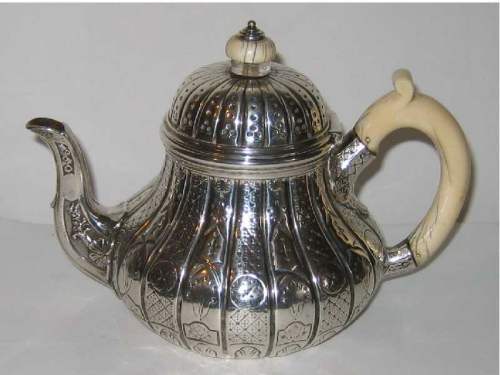
|
|
Height 16 cm, width 21 cm, weight 572 g
|
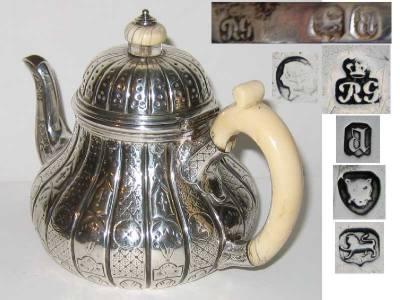 This teapot was manufactured in London by
Royal Silversmith Robert Garrard, one of the most celebrated makers
of the Victoria period, and the favourite silversmith of Queen
Victoria.
This teapot was manufactured in London by
Royal Silversmith Robert Garrard, one of the most celebrated makers
of the Victoria period, and the favourite silversmith of Queen
Victoria.
Underneath the base are impressed the hallmarks: RG under a crown
(maker mark); lion passant (sterling standard for silver, 925 ppt);
leopard head (Assay Office mark for London); a small old English
letter 'a' (date letter for 1856/1857) and Queen Victoria head (duty
mark). The base is inscribed 'Garrards Panton Street LONDON'.
The lion passant, the date letter and the maker marks are struck
also inside the lid.
The pot has a pear shaped body which was in great fashion in the late
Queen Anne and the early Georgian period. It has ivory handle and
finial.
|
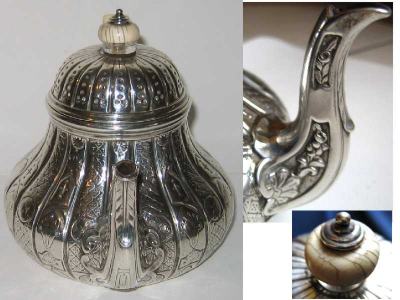 The teapot is decorated with vertical segments
embossed in medieval style, covering its entire body (the so-called
'neo-gothic' style).
The teapot is decorated with vertical segments
embossed in medieval style, covering its entire body (the so-called
'neo-gothic' style).
The pot is mainly hand made, but the body is manufactured using the
'spinning' technique (note 1).
The manufacture is of high level, mainly in the details.
|
TEAPOT WITH INDIAN ETHNIC DECORATION - LONDON 1869
|
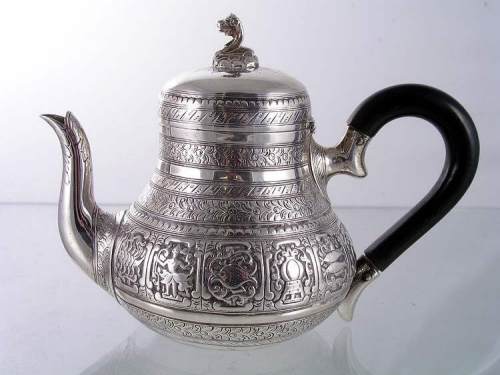
|
|
Height 13 cm, width 18 cm, weight 291 g
|
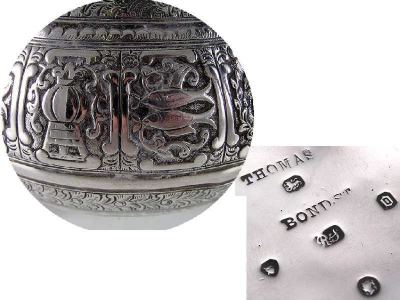 This teapot was manufactured in London by the
silversmith Richard Sibley.
This teapot was manufactured in London by the
silversmith Richard Sibley.
The hallmarks are impressed underneath the base: RS (maker mark);
lion passant (sterling standard for silver, 925 ppt); leopard head
(Assay Office mark for London); a small old English letter 'o' (date
letter for 1869/1870)and Queen Victoria head (duty mark). Under the
base is also impressed the inscription 'THOMAS BOND ST' (a well
known London retailer).
The lion passant, the date letter and the maker marks are also
struck inside the lid. The pot has the pear shape body, a wood
handle and a soldered silver finial in the shape of a snake head
(usually the teapots' finials weren't soldered, but screwed down to
the lid).
|
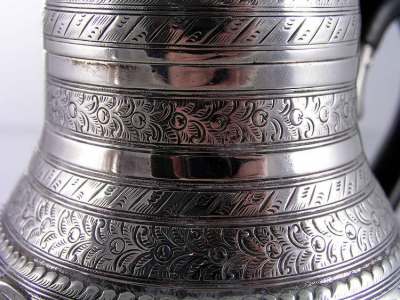 The embossed decoration, held in horizontal
sectors, is entirely inspired by Indian ethnic designs, including
zodiacal symbols, covering the entire body of the pot.
The embossed decoration, held in horizontal
sectors, is entirely inspired by Indian ethnic designs, including
zodiacal symbols, covering the entire body of the pot.
The pot is mainly hand made but the body is manufactured by the
'spinning technique' (note 1). The manufacture is of high
level. |
(1) spinning: a technique introduced at the end of 18th
century. A flat sheet of silver was pushed against a mould using a lathe.
This technique, an outgrowth of the Industrial Revolution widely applied
in 19th century, smoothes the pot's inside, avoids soldering and
hammering signs (unless later intentional additions) but sometimes produces
objects of meagre solidity and weight, requiring a double hem to
reinforce the edge.
Giovanni Ciceri - 2005
English text revision by Jayne Dye
|